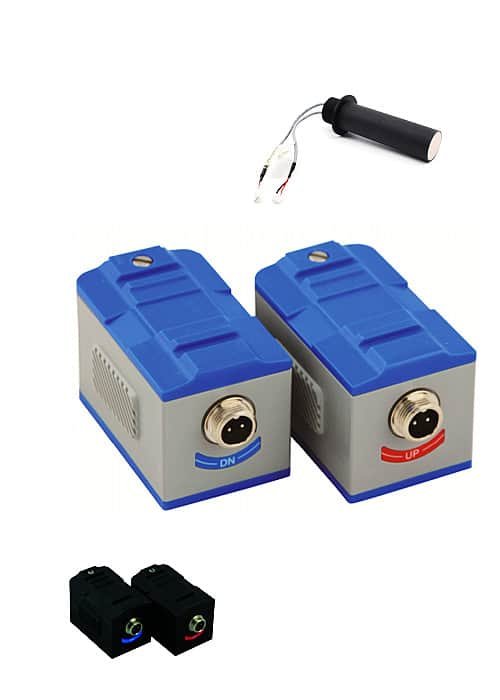Ultrasonic flow detectors are an important part of ultrasonic flow meters. Ultrasonic flow detectors are also called ultrasonic transducers. Ultrasonic flow detectors measure the volumetric flow of liquid within closed conduits. Ultrasonic flow meters use transit-time differences for measuring flow rates inside pipes from the outside using electronics and digital signal processing technology.

Featured Ultrasonic Flow Meters Clamp-on
Features of Ultrasonic Flow Detectors
Optional Ultrasonic Flow Detectors
| Types | Picture | Spec. | Model | Measurement Range | Temperature | Dimension |
| Clamp on |
|
Small Size | TS-2 | DN15~DN100 | -30~90℃ | 45×25×32mm |
|
|
Medium Size | TM-1 | DN50~DN700 | -30~90℃ | 64×39×44mm | |
|
|
Large Size | TL-1 | DN300~DN6000 | -30~90℃ | 97×54×53mm | |
| High Temperature Clamp on |
|
Small Size | TS-2-HT | DN15~DN100 | -30~160℃ | 45×25×32mm |
|
|
Medium Size | TM-1-HT | DN50~DN700 | -30~160℃ | 64×39×44mm | |
|
|
Large Size | TL-1-HT | DN300~DN6000 | -30~160℃ | 97×54×53mm | |
| Mounting Bracket Clamp on |
|
Small Size | HS | DN15~DN100 | -30~90℃ | 318×59×85mm |
|
|
Medium Size | HM | DN50~DN300 | -30~90℃ | 568×59×85mm | |
|
|
Extended | EB-1 | DN300~DN700 | -30~90℃ | 188×59×49mm | |
| High Temperature Mounting Bracket Clamp on |
|
Small Size | HS-HT | DN15~DN100 | -30~160℃ | 318×59×110mm |
|
|
Medium Size | HM-HT | DN50~DN300 | -30~160℃ | 568×59×110mm | |
|
|
Extended | EB-1-HT | DN300~DN700 | -30~160℃ | 188×59×49mm |
| Moeld | X3-φ6.35 | X3-φ9.53 | X3-φ12.7 | X3-φ15 | X3-φ20 | X3-φ25 |
| Weight(KG) | 0.91 | 0.91 | 0.9 | 0.9 | 0.84 | 0.84 |
| Moeld | X3-φ32 | X3-φ40 | X3-φ50 | X3-φ63 | X3-φ75 | X3-φ99 |
| Weight(KG) | 0.82 | 0.88 | 0.98 | 1.43 | 1.52 | 1.95 |
Ultrasonic Flow Detectors Working Principle
Ultrasonic Flow Detectors are also called ultrasonic transducers. In fact, it is a piezoelectric ceramic whose frequency is the same as its resonant frequency. It uses the piezoelectric effect of the material to convert electrical energy into mechanical vibration.
Under normal circumstances, ultrasonic waves are first generated by an ultrasonic generator. It is converted into mechanical vibration by the ultrasonic transducer. The ultrasonic wave can be generated by the ultrasonic wave deriving device and the ultrasonic wave receiving device.
Ultrasonic transducers mainly include shell, acoustic window (matching layer), piezoelectric ceramic disc transducer, backing, lead-out cable, receiver, and other parts.
Among them, the piezoelectric ceramic disc transducer plays the same role as a general transducer. It is mainly used to transmit and receive ultrasonic waves, and above the piezoelectric ceramic disc transducer is the receiver. It is mainly composed of lead cables, transducers, metal rings, and rubber washers. Used as an ultrasonic receiver. Receive the Doppler dial-back signal generated outside the frequency band of the piezoelectric ceramic disc transducer.
Ultrasonic transducers are piezoelectric ceramics that resonate at ultrasonic frequencies. The piezoelectric effect of the material converts electrical signals into mechanical vibrations. The ultrasonic transducer is an energy conversion device. Its function is to convert the input electric power into mechanical power (ultrasound) and then transmit it out. , It consumes a small part of its own power.
Types of ultrasonic transducers: can be divided into piezoelectric transducers, sandwich transducers, cylindrical transducers, inverted horn transducers, and so on.
Frequently
Asked
Questions
Related blogs
Sino-Inst, Manufacturer for Ultrasonic Flow Meters. It can measure a single sound-conducting liquid medium of DN 25—150mm. It can measure even liquids such as water, seawater, oil, and slurry.
Sino-Inst’s Ultrasonic Flow Meter, made in China, Having good Quality, With better price. Our flow measurement instruments are widely used in China, India, Pakistan, the US, and other countries.
Wu Peng, born in 1980, is a highly respected and accomplished male engineer with extensive experience in the field of automation. With over 20 years of industry experience, Wu has made significant contributions to both academia and engineering projects.
Throughout his career, Wu Peng has participated in numerous national and international engineering projects. Some of his most notable projects include the development of an intelligent control system for oil refineries, the design of a cutting-edge distributed control system for petrochemical plants, and the optimization of control algorithms for natural gas pipelines.